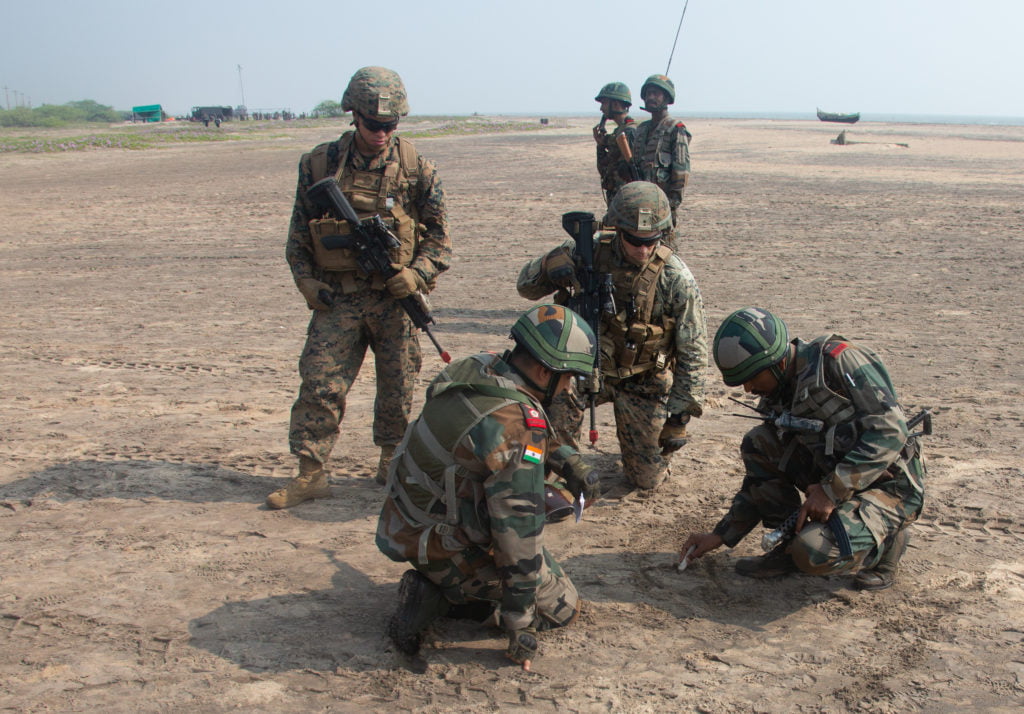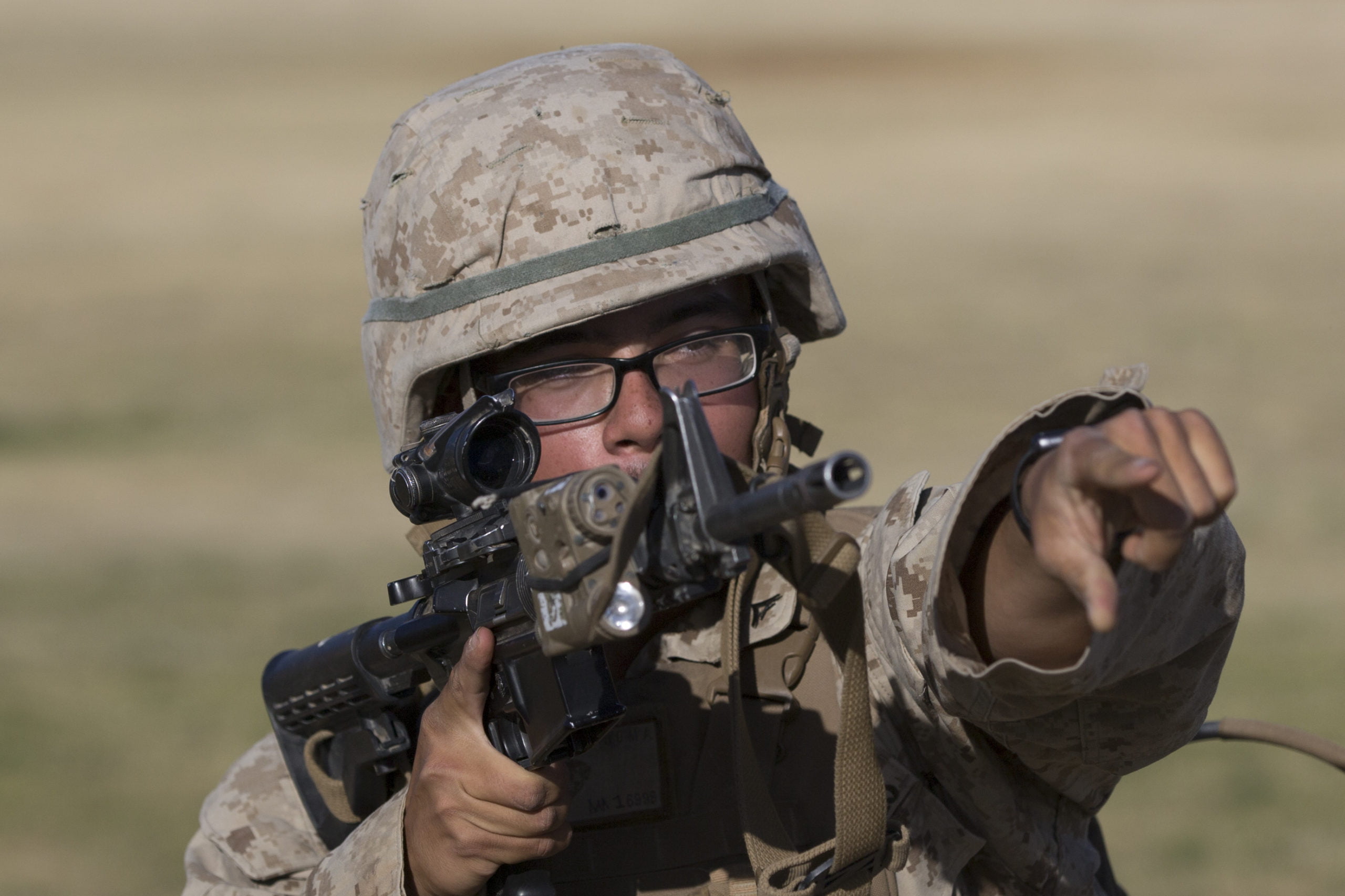By Robbin Laird
During my visit to MAWTS-1 in November 2023, I had a chance to talk with Maj Scott Mahaffey, the Department Head for the Ground Combat Department.
Maj Mahaffey has been at MAWTS for three years but prior to that has had a number of deployments, including Afghanistan, with an SP-MAGTF, which involved operations in Africa, and participation in a number of exercises such as Trident Juncture in Norway in 2018, the first exercise with the Indians, in the Tiger Triumph Exercise, and exercises in the Philippines.
His background provided a very good preparation for taking on the demanding task of working the training of the GCE as it works its transition from more traditional ground operations associated with the land wars to a wider range of force insertion missions.
According to Mahaffey: “Predominantly our portion of WTI we call our Air Assault and Fires Integration course. It is a heavy flavor from a ground and ACE perspective of how to execute air assaults from battalion sized raid to a platoon-sized lift. The fires integration piece at least from our student’s perspective is focused on fires integration with air-delivered weapons and how they can mesh and integrate with ground fires not necessarily in the close in battlespace but in the deep enclosed battlespace.
“Our students are typically captains at the company level, some senior enlisted, gunnies or master sergeants, with a sprinkling of lieutenants. They have focused on how to accomplish a company objective with close in fires, and we focus on training to give them knowledge of fires support at higher echelon support. We are focused on training which enhances their knowledge of the broader battlespace and how F-35 or HIMARS fires provide support for a broader engagement in the battlespace.”

When I was last at MAWTS in 2020, there was significant concern with deploying Marines to remote locations, even if new longer-range weapons will come on line in the next few years, with the question of fires authorities. In the MAGTF construct, the question of who gives fires authority is clear; in the new direction to have smaller groups of Marines deployed throughout the battlespace, that question is not yet resolved.
The other issue is that GCE is training in the absence of the longer-range weapons which are not yet in place. They are using data from weapons development efforts, a step up from briefing slides, to work with notional weapons, NEMESIS being a case in point.
The challenge facing the GCE is seen in this USMC 2021 description of NEMESIS.
The Navy/Marine Corps Expeditionary Ship Interdiction System successfully hit its target in support of Marine Corps Forces, Pacific, during Large Scale Exercise 21 Aug. 15, 2021. The exercise showcased the U.S. maritime forces’ ability to deliver lethal, integrated all-domain naval power.
LSE 21 was a live, virtual and constructive scenario-driven, globally-integrated exercise with activities spanning 17 time zones. LSE 21 applied and assessed developmental warfighting concepts that will define how the future Navy and Marine Corps compete, respond to crises, fight and win in conflict.
The Marine Corps’ NMESIS will provide the Marine Littoral Regiment with ground based anti-ship capability to facilitate sea denial and control while persisting within the enemy’s weapons engagement-zone, and LSE 21 provided a venue for the program team to validate some of those concepts.
“This scenario is representative of the real-world challenges and missions the Navy and Marine Corps will be facing together in the future,” said Brig. Gen. A.J. Pasagian, commander of Marine Corps Systems Command. “This exercise also provided an opportunity for us to work alongside our service partners to refine Force Design 2030 modernization concepts.”
SINKEX, the exercise scenario involving NMESIS, provided a testing environment for new and developing technologies to connect, locate, identify, target and destroy adversary threats in all domains, culminating in the live-fire demonstration of the naval strike missile against a sea-based target. During the exercise, forward-deployed forces on expeditionary advanced bases detected and, after joint command and control collaboration with other U.S. forces, responded to a ship-based adversary. Simultaneous impacts from multiple, dispersed weapons systems and platforms across different U.S. services—including NMESIS—engaged the threat.
NMESIS integrates established, proven sub-systems, such as the Joint Lightweight Tactical Vehicle Chassis, the Naval Strike Missile and the Fire Control System used by the Navy for NSM.
“From an acquisition perspective, NMESIS started a little over two years ago,” said Joe McPherson, long range fires program manager at MCSC. “We’ve been able to rapidly move [on developing and fielding this system] because we’re leveraging existing NSM and JLTV subsystems.”
Because NMESIS is not yet a fielded capability, engineers from MCSC managed the fire control piece of the system during the exercise. Marines, however, were able to practice maneuvering the system and validating the system’s interoperability with their Naval and Air Force partners.
The basic focus of the Ground Combat Department at MAWTS-1 is upon company training and awareness of higher echelon support, both actual and projected such as the case with NEMESIS.
Maj Mahaffey indicated that simulators are a key part of the training regime, which allows for lessons learned to be taken away and reflected in the simulators which are located at the Marine Corps bases as well. This allows for working the standardization aspect of the training development process.
But they don’t have a simulator for a new system such as NEMESIS and are working with a notional projected system as part of their training regime. They are training in terms of working the timelines to execute a strike with the notional system to support an external fires authority.
The reality for the GCE is that currently have organic fires which allow them to operate in the close in fight. Longer range fires are in development, with HIMARS at an outer range of 300Kms being the exception.
But by and large the GCE projected in remote locations is largely capable of providing defensive capability, protecting logistical locations, or radars or items of interest, not being part of an offensive punch for the joint force.
It is a work in progress.
Featured Photo: U.S. Marines assigned to 1st Battalion 4th Marines post security during assault support tactics three during Weapons and Tactics Instructor Course 2-18 in Yuma, Ariz., on April. 20, 2018. WTI is a seven week training event hosted by Marine Aviation and Weapons Tactics Squadron One cadre which emphasizes operational integration of the six functions of Marine Corps aviation in support of a Marine Air Ground Task Force. MAWTS-1 provides standardized advanced tactical training and certification of unit instructor qualifications to support Marine aviation Training and Readiness and assists in developing and employing aviation weapons and tactics. (U.S. Marine Corps photo by Lance Cpl. Joel Soriano)


